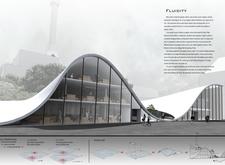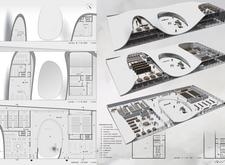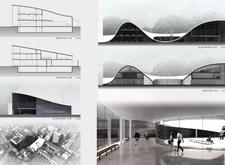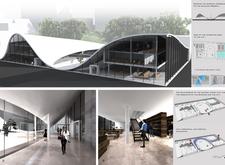5 key facts about this project
At the core of this architectural endeavor lies the idea of movement. The building's design features a unique wave-like silhouette that captivates the eye while embodying the concept of fluidity in both form and function. This architectural approach not only enhances the aesthetics of the structure but also facilitates an intuitive flow throughout the space. The careful arrangement of interior areas supports a seamless transition between different uses, allowing occupants to navigate the building naturally and efficiently.
One of the notable aspects of the Fluidity project is its emphasis on transparency and light. The extensive use of glass in the facade creates an interconnected experience between interior and exterior environments. This decision enhances daylighting within the building while offering panoramic views, ultimately blurring the boundaries that typically segregate nature from architecture. The glass facade invites users to appreciate the surrounding landscape, fostering a sense of belonging and connection to the wider community.
The interior layout of the project reflects a versatile design that accommodates various functions. Open-plan exhibition spaces invite creativity and innovation, while dedicated areas for workshops and lectures provide the necessary resources for educational pursuits. The central atrium acts as a communal heart, drawing visitors into the building and encouraging serendipitous encounters and social interactions. This thoughtful organization of space cultivates a dynamic atmosphere, aligning perfectly with the project’s goal of promoting communal engagement.
In considering the materiality of the Fluidity project, the architecture demonstrates a careful selection of materials that align with the overall design ethos. The structural integrity is achieved through the use of concrete and steel, which allows for the construction of intricate forms without compromising stability. These materials are complemented by warm wooden elements that are strategically integrated into the interiors, softening the overall aesthetic and creating inviting spaces for occupants.
The unique design approaches taken in the Fluidity project set it apart within contemporary architectural discourse. The building reflects a commitment to sustainability through its responsible use of materials and energy-efficient design principles. The integration of biophilic elements, such as indoor green spaces and natural light, fosters a healthier indoor environment and supports the well-being of its users. Furthermore, the adaptability of the spaces signifies a modern understanding of functionality in architecture, allowing the building to evolve and meet the changing needs of its occupants.
In summary, the Fluidity project encapsulates a unique vision of architecture that values connectivity, user experience, and environmental integration. Its design encourages exploration, interaction, and creativity while remaining sensitive to its surroundings. For those interested in delving deeper into the architectural plans, sections, designs, and ideas behind this project, exploring the detailed presentation will provide valuable insights into its conception and execution.


























